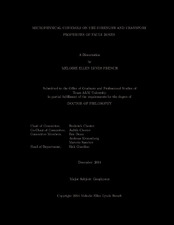| dc.description.abstract | Two studies on the mechanical properties of smectite-rich fault gouge collected from the Central Deforming Zone (CDZ) of the San Andreas Fault (SAF) in the San Andreas Fault Observatory at Depth (SAFOD) are presented. Rotary shear experiments were conducted at co-seismic slip rates (0.1 to 1 m/s). Displacement and dynamic weakening result from slip along clay-foliation assisted by shear-heating pressurization of pore fluid in wet gouge and additional grain-size reduction and possible clay dehydration in dry gouge. The results of a stability analysis show that microseismic patches within the CDZ should arrest at in-situ deformation conditions despite the documented weakening of the gouge. In some cases, however, weakening may be sufficient to sustain propagation of a rupture that nucleates within the adjacent locked segment into the CDZ.
Stress-relaxation tests were also conducted on the CDZ gouge, and achieved strain-rates within an order of magnitude of in-situ creep (~ 10^-10 s^-1). The gouge is frictionally weak (< 0:15) at all conditions tested, and exhibits a change in the rate-determining mechanism at strain-rates below 10^-8 s^-1. A microphysical model for deformation of the CDZ gouge is hypothesized; the strength of the CDZ gouge is consistent with intergranular sliding whereby geometric obstacles deform by fracture/delamination and dislocation glide operating as parallel-concurrent mechanisms. At strain-rates greater than 10^-8 s^-1, fracture/delamination are the rate-controlling processes, and at lower rates, dislocation glide is rate-controlling.
To understand the effects of stress and deformation on fluid flow through faulted rock, the permeability of faulted, damaged, and intact sandstone, was measured and mapped with respect to effective mean stress (15 to 100 MPa), differential stress (0 to 140 MPa), and proximity to frictional failure. The permeability and porosity of intact and faulted Punchbowl Formation Sandstone, a low-porosity (7 %) low-permeability (10^-18 m^2) altered arkosic sandstone, are strongly correlated with mean stress and insensitive to differential stress and proximity to the failure envelope. The fault core is a conduit with enhanced permeability. Porosity-permeability relations indicate that the microphysical controls of the stress-dependence are the same for intact and faulted rock despite higher microfracture densities and a localized fluid conduit. | en |


